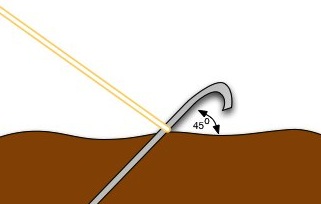The humble tent peg
13/10/13 12:37 Filed in: Management
Somewhere in the dim past as a scout I remember seeing a diagram about how to use a tent peg … one would have thought such a simple bit of equipment would not need much explanation and people would use them correctly … but no I keep bumping into incorrectly used pegs … the major point here is that correct use is not actually obvious even as simple as a tent peg.
If I remember correctly the correct use of a tent peg is to:

The most common error is that people use the hook on the end for attaching the rope. This tends to result in bent pegs at ground level. This results from the ground holding the peg and the maximum lever arm being generated from the rope acting at the top of the peg. If the peg had been used correctly one of two things would have happened, the ground would have given way or the peg would have sheared1. Both these are cataclysmic failures and occur at the limits of performance i.e. the peg has done all it could and the only way to avoid this type of failure is to pick a different type of tent peg.
The moral of this story is that if something as simple as a tent peg can be almost universally misused by naive and untrained users then what hope is there for more complex equipment without significant effort being put in by the designers and implementers of systems.
As an interesting aside while investigating this article I decided that the old saw about inventing a better mouse trap should really be rewritten about tent pegs - there are a profusion of new and improved designs of the humble tent peg yet still the bent bit of metal persists in spite of its near universal incorrect application2,3.
1. The non-elastic limit of the metal in a tent peg is usually much lower that the shearing point of the metal
2. These new implementations are almost always more expensive than the simple metal deigns they are replacing.
3. Abusers of tent pegs can also always buy over specified (thicker, more costly, heavier) metal ones such that the non-elastic limit of the metal is not exceeded - however - if you are camping and carrying your gear lighter is better and a correctly guyed tent is far more comfortable than the alternative if it is wet and raining.
- insert it at 45 degrees to the ground (for maximum resistance to being pulled out),
- attach the rope at ground level (puts lets stress on the metal of the peg)
- the hook on the end of the peg is for pulling out the peg

The most common error is that people use the hook on the end for attaching the rope. This tends to result in bent pegs at ground level. This results from the ground holding the peg and the maximum lever arm being generated from the rope acting at the top of the peg. If the peg had been used correctly one of two things would have happened, the ground would have given way or the peg would have sheared1. Both these are cataclysmic failures and occur at the limits of performance i.e. the peg has done all it could and the only way to avoid this type of failure is to pick a different type of tent peg.
The moral of this story is that if something as simple as a tent peg can be almost universally misused by naive and untrained users then what hope is there for more complex equipment without significant effort being put in by the designers and implementers of systems.
As an interesting aside while investigating this article I decided that the old saw about inventing a better mouse trap should really be rewritten about tent pegs - there are a profusion of new and improved designs of the humble tent peg yet still the bent bit of metal persists in spite of its near universal incorrect application2,3.
1. The non-elastic limit of the metal in a tent peg is usually much lower that the shearing point of the metal
2. These new implementations are almost always more expensive than the simple metal deigns they are replacing.
3. Abusers of tent pegs can also always buy over specified (thicker, more costly, heavier) metal ones such that the non-elastic limit of the metal is not exceeded - however - if you are camping and carrying your gear lighter is better and a correctly guyed tent is far more comfortable than the alternative if it is wet and raining.
